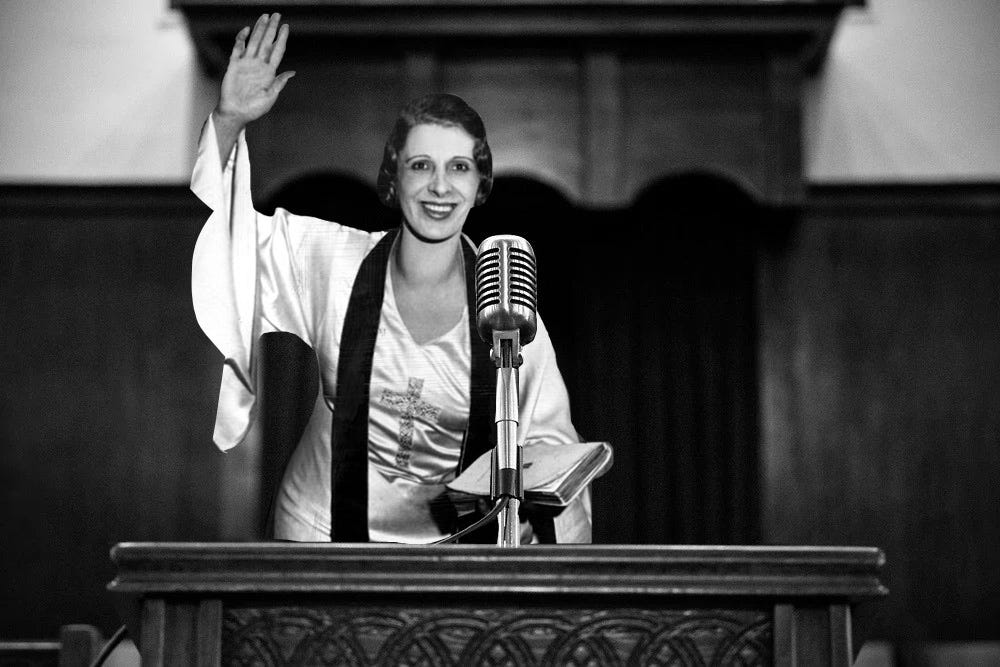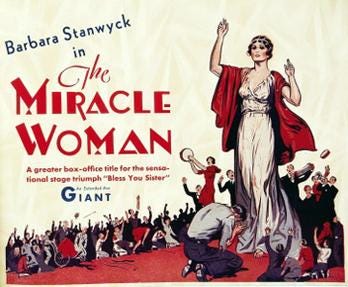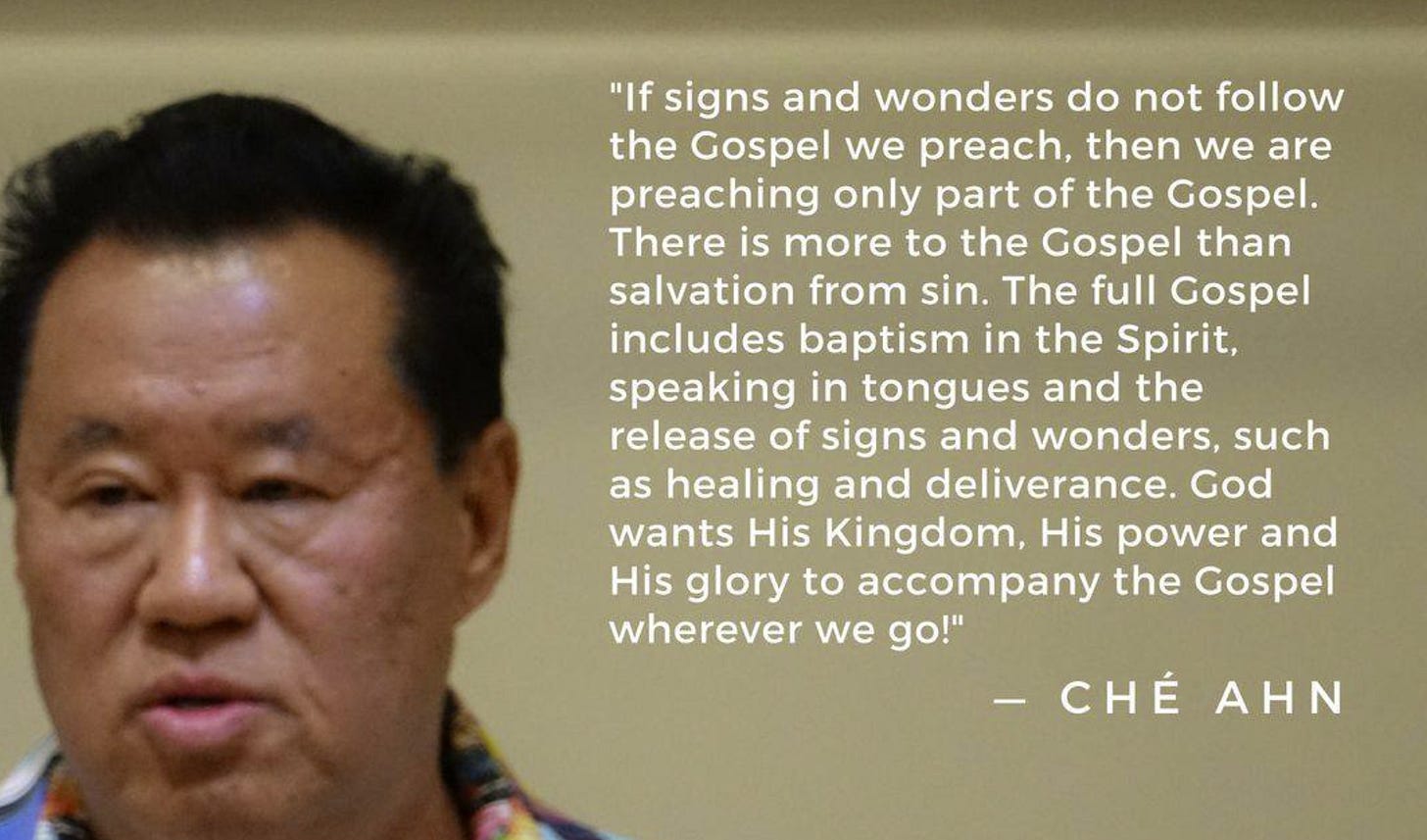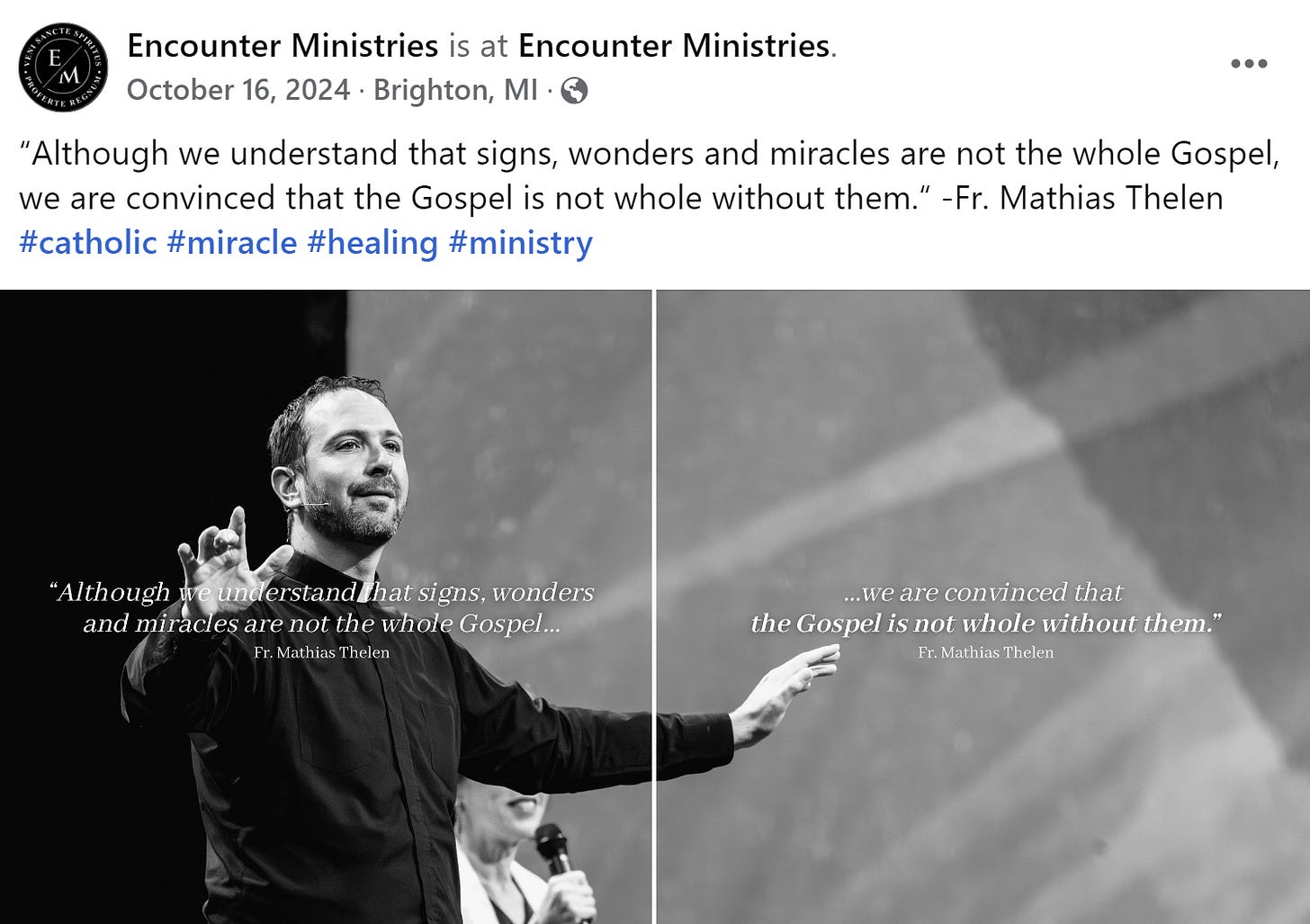The good folks at Catholic Answers pose two questions: “What does the expression Full Gospel mean? Does it imply Catholics have only half the gospel?” Their response contains two statements: “We have the entire gospel. A church describing itself as Full Gospel is probably Pentecostal.” That first statement is correct. However, some Catholics have recently said things that call the second statement into question. Before we get to that, we need to know where “full Gospel” came from, and what it means.
The Origins of “Full Gospel”
The internet attributes the term to A.B. Simpson (1843-1919), a Canadian preacher and founder of the Alliance World Fellowship. Raised and ordained as a Presbyterian, he later left that denomination and established an independent evangelical mission. Simpson outlined his views in a series of sermons in 1887, which were published in 1890 as The Fourfold Gospel. He summarized the full Christian message in four titles of Jesus that express the four pillars of the Gospel: "Jesus our Savior, Sanctifier, Healer, and Coming Lord" Simpson stressed that there is more to the Christian message than salvation by grace, or “being saved.” Once saved, the believer could be sanctified by grace, made entirely holy even before dying and going to heaven.1 In fact, Simpson’s book does not contain the expression “full Gospel,” but he believed that to omit one or more of the “four pillars” would be to omit an essential part of the Gospel.
The first to use the actual phrase “full Gospel” may have been that pioneer of Pentecostalism, Charles Fox Parham (1873-1929). Parham recalled preaching in Kansas City in January of 1901:
I have on record the sermon preached on this occasion. The first upon the baptism of the Holy Ghost in all modern Pentecostal Apostolic Full Gospel movements.
In another sermon, Parham said,
The Lord demands today of every true follower that he drop narrow creedisms, sink denominationalism into oblivion, accept the full gospel with all its gifts and graces, and purify their hearts for His soon coming, or be lost in the chaos and darkness of the coming overthrow of nations…
For Parham, to accept the “full Gospel” meant not only receiving salvation and sanctification, but also receiving the “baptism of the Holy Spirit” and exercising spiritual gifts, especially the gift of tongues. A similar definition was given by J Tomlinson, the first general overseer of the pentecostal Church of God (Cleveland, TN).
J. Tomlinson…apparently was one of the first persons to identify the movement’s message as the “Full Gospel.” Writing in his journal on June 22, 1908, Tomlinson described a revival he was conducting in Chattanooga: “The signs are blessedly following the preaching of a full gospel.”
Even if Simpson never spoke of the “full Gospel,” his teaching on the fourfold Gospel would influence someone who did help popularize the term, and so lead the way to a fuller meaning of “full Gospel;” namely,
Aimee Semple McPherson (1890-1944).
Born in Canada, “Sister Aimee” was the most famous Protestant evangelist of her time. She became a Pentecostal in 1907 and shortly afterward moved to Chicago, joining the North Avenue Mission, pastored by William Durham (1873-1912). There she interpreted the utterances of people speaking in tongues. In 1913 she began working as a traveling evangelist, preaching missions, and eventually beginning to practice faith healing. Her success drawing large crowds in Los Angeles led to her staying there, where she built her own church, Angelus Temple in Echo Park. Dedicated in 1923, the auditorium seats 5,300 and is considered the first megachurch in the United States. McPherson’s innovative preaching style, modern communication methods, and especially faith healing brought her immense media attention. Her fame almost certainly inspired a 1931 film starring Barbara Stanwyck.
In October, 1922, McPherson gave a sermon presenting the “Foursquare Gospel.” She identified four aspects of Christ: "Jesus the Savior, Jesus the Baptizer with the Holy Spirit, Jesus the Healer, and Jesus the Soon-Coming King." These four aspects correspond to the four pillars of the “full Gospel:” salvation, post-baptismal sanctification, supernatural healing, and the second coming of Christ. While McPherson claimed that these ideas came to her in a vision, her four titles and pillars line up exactly with A.B. Simpson’s Fourfold Gospel. She also said that for some time before having the vision, she had not been fully satisfied with the term “Full Gospel,” though she had used it in her writings. The following year, this sermon gave a name to the denomination she founded: Foursquare Church.
Today, the Foursquare Church believes:
“in the personal Baptism of the Holy Ghost as received by the apostles,” which… means that they believe the baptism of the Holy Spirit is a “second blessing” subsequent to salvation. Along with this, they believe that all of the miraculous gifts of the Spirit are active in the church today.
The Full Gospel Businessmen’s Fellowship International
The belief that acceptance of the “full Gospel” would lead to the experience of pentecostal gifts, including miracles, was spread by the Full Gospel Businesmen’s Fellowship International, founded by businessman Demos Shakarian2 in 1952. Oral Roberts was heavily involved in the founding, and was one of many “full Gospel” preachers who used the Letter to the Romans to connect the “full Gospel” and miraculous healings. The passage he and others used to support this understanding does not contain the precise phrase “full Gospel:”
…by the power of signs and wonders, by the power of the Holy Spirit, so that from Jerusalem and as far round as Illyricum I have fully preached the gospel of Christ (Romans 15:19 RSV).
Roberts cited this passage to support his definition of the “full Gospel,” teaching that all the first preachers of Christ experienced signs and wonders whenever they “fully preached” the Good News:
the apostles began to discover that whenever they “fully preached” the Gospel of Jesus Christ, miracles broke out! They didn’t start out preaching miracles…they preached Christ. But, when they preached Christ, miracles happened! The Apostle Paul wrote: “Through mighty signs and wonders, by the power of the Spirit of God; so that from Jerusalem, and round about unto Illyricum, I have fully preached the gospel of Christ” (Romans 15:19). In other words, wherever Paul preached the Gospel of Christ, sign and wonders followed.
We can see that Roberts, like J. Tomlinson (quoted above), is saying that miracles “follow” the preaching of the full Gospel. Oral Roberts’ son, Richard, carries on this teaching today.
Today, Richard focuses on his Greater Works international pastors conferences where he teaches and trains pastors in underdeveloped nations to take the full gospel with miracles, healing and signs following to their villages, cities, and nations, as Jesus said in John 14:12.
We can see a restorationist mindset here. Discourse about the “full Gospel” goes hand-in-hand with the assumption that the church today must look and act like the church of Acts, and that believers today should be doing the same miraculous works that Jesus did (cf. John 14:12). This is one of the links between the early twentieth-century pentecostal movement and
the New Apostolic Reformation.
Within the NAR, Oral Roberts’ understanding of “full Gospel” continues to be passed on. It is propagated by such leading NAR figures as Randy Clark, Bill Johnson and Ché Ahn. Clark, leader of the Global Awakening healing and revival ministry, does not emphasize the term “full Gospel,” but does teach the doctrine, stating that the “fullness of the Gospel” and the message of the Kingdom includes not only the preaching of the word, but the demonstration of God’s power through signs and wonders, appealing to Romans 15:19.
Johnson, senior pastor of Bethel Redding, gave a sermon affirming that the Full Gospel is signs and wonders. Johnson supports this teaching by quoting Romans 15:19.
Ché Ahn, pastor of Harvest Rock Church in Pasadena, Calfornia, and International Chancellor of Wagner University, an unaccredited school founded by C. Peter Wagner, speaks explicitly of the “full Gospel,” and says that the Gospel is not complete if it is not followed by signs and wonders:
Catholics and the full Gospel
One Catholic group, Encounter Ministries, has introduced this same teaching into their activity, with a slight change of wording. Instead of “full Gospel,” they say that the Gospel is not “whole” without signs and wonders. as seen in this Facebook post, which repeats a tagline from their website:
Why does Fr. Mathias Thelen say that? Knowing the history behind the phrase, we can see that he is simply passing on the “full Gospel” teaching of the 20th-century pentecostal movement, but expressing it in slightly different words. He is saying the same thing that the pentecostal Church of God (Cleveland, TN) says:
The title Full Gospel has historically been used to identify those denominations and fellowships, otherwise known primarily as Pentecostals, who hold to the belief that whatever God did through the Church in New Testament times, and principally in the Book of Acts, He still does today.
In a previous post, we saw how Fr. Thomas Weinandy likewise held that a post-salvation pentecostal experience can give to Christians already baptized and confirmed “the fullness of Pentecost,” so that “their preaching of the word is accompanied by miracles, healings, and exorcisms.” In fact, this is a “full Gospel” approach, and aligns exactly with what the Foursquare Church believes about a “second blessing” following baptism, and what Oral Roberts taught about miracles following the preaching of the full Gospel.
Does the Catholic Church Teach This?
No. The Catholic Church does not teach that the preaching of the Gospel is incomplete when it is not followed by signs and wonders. We do say that our faith is based on the miracle of the Incarnation. Pope Benedict XVI said,
While we too always seek other signs, other wonders, we do not realize that he is the real sign, God made flesh; he is the greatest miracle of the universe: all the love of God hidden in a human heart, in a human face.
The Catholic Church does not use the language of the “full Gospel.” That phrase was invented by people who believed that something essential had been lost to the Church, and needed to be restored. But the Catholic Church has always preserved and handed on the essential truths of the Faith.
What precisely “the Gospel” means to a Catholic is a very interesting question, as Bishop Robert Barron points out in n short essay that every Catholic should read. Like A.B. Simpson and Aimee Semple McPherson, a Catholic believes that the Gospel is about more than just “being saved;” it also includes post-salvation growth in holiness and living in expectation of Christ’s coming. But instead of saying that the Gospel is incomplete without signs and wonders, Catholics know that their own lives are incomplete if they do not live a sacramental life in full communion with the Church. Doing so will lead to, as the Council of Trent said, “an increase in justification” and, for those who receive the grace of final perseverance, resurrection and glorification.
The Fathers of the Council of Trent, in a document cited by the Fathers of the Second Vatican Council, offered a definition of “Gospel” that is not restricted to “being saved:”
the Gospel… promised through the prophets in the holy Scriptures, our Lord Jesus Christ, the Son of God, first promulgated with His own mouth, and then commanded to be preached by His Apostles to every creature, as the fountain of all, both saving truth, and moral discipline; … this truth and discipline are contained in the written books, and the unwritten traditions which, received by the Apostles from the mouth of Christ himself, or from the Apostles themselves, the Holy Ghost dictating, have come down even unto us…
“Saving truth and moral discipline—” in other words, both faith and a holy life are part of the fullness of the Gospel, and no Christian’s life is complete without both. Catholics allow for the possibility of miracles, including the wondrous miracle of God’s grace that is a Christian life fully lived in faith, hope, and charity. One who believes and lives in this way can be a saint, and receive the gift of eternal life, even if he or she never sees anyone miraculously healed of some bodily infirmity. We must not say that such a person has led an incomplete Christian life, or known an incomplete Gospel.
Faithful Reader, here is the full Gospel: When the truth of Christ’s message is fully accepted in faith, and fully lived within the community of the Church, then are the words of Christ fulfilled: “These things I have spoken to you, that my joy may be in you, and that your joy may be full” (John 15:11 RSV).
In this Simpson had been influenced by the Keswickians, who in turn were inspired by Charles Wesley’s teaching on holiness.
Demos Shakarian’s grandfather, also named Demos Shakarian, was involved in the Azusa Street revival. Demos the younger was also the nephew of Kim Kardashian’s great-grandfather.









Great research here. I've followed the same breadcrumbs back through history in my examination of the NAR. I also agree that Believers do not have just half the Gospel as the NAR intimates. I also agree with your statement that "the Gospel is about more than just 'being saved' it also includes post-salvation growth in holiness and living in expectation of Christ’s coming." Scripture clearly teaches 3 doctrines related to eternal salvation: 1. Justification (obtained at the moment we put our faith in Christ and His Atonement. Then, His righteousness is subsequently imputed to our accounts and we receive the indwelling of His Spirit); 2. Sanctification (which is what you describe as "post-salvation growth in holiness"); and 3. Glorification (when our bodies are quickened as per 1 Corinthians Chapter 15, either upon our death or the Rapture, whichever comes first). The concept of "Greater Works" is not part of the Gospel. In fact, it is not even part of the Great Commission that Jesus gave His disciples in Mt 28:19, 20.